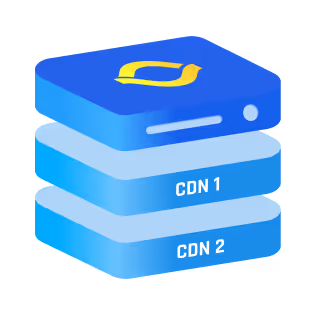How the Bot Detection Layer Affects Bot Management Strategies?
Table of contents
The bot detection layer is the heart of any bot management system. It’s what decides whether traffic is human or automated. If your detection layer is strong, your bot strategy works. If it’s weak, your strategy fails—simple as that.
When you’re building, or relying on, a bot management system, it all comes down to one key question: How well can it detect bots, or even a botnet in the first place?
Everything else (blocking, rate limiting, redirecting, challenge pages, behavioral fingerprinting, you name it) is built on top of the detection layer.
What Exactly Is the Bot Detection Layer?
Think of it like the “eyes and brain” of your bot management system. Its job is to analyze every request and figure out:
Is this coming from a real human, or is it a script, botnet, scraper, or automated crawler?
And to do that, it uses a combination of techniques:
- Fingerprinting (browser or device)
- Behavioral analysis (mouse movement, typing speed, interaction patterns)
- Rate analysis (how fast and how often requests come)
- Header and payload inspection
- IP reputation and ASN analysis
- TLS fingerprinting
- Machine learning models trained on traffic patterns
The more signals you use, the more accurate the detection becomes. But here’s the catch—accuracy is everything. You need high true positives (detecting actual bots), but also low false positives (not mistaking humans for bots).
This balance directly influences your bot risk management approach. Why? Because if detection is too strict, you block good users. If it's too lenient, you let bad bots in.
So, How Does the Detection Layer Affect Your Strategy?
Here’s where things get interesting. Your bot management strategy—what actions you take against bots—depends entirely on how confident you are in your detection layer.
Let’s say your detection layer is 90% accurate. That means for every 100 bot requests, you catch 90, and maybe accidentally block 2-3 legit users. If you trust your layer that much, you can afford to:
- Serve CAPTCHAs
- Block directly
- Use JavaScript challenges
- Redirect suspicious requests
But now imagine it’s only 60% accurate. Would you risk a CAPTCHA or a block? Probably not. That kind of inaccuracy forces you to go defensive—maybe throttle them slightly, or feed them junk data instead of the real site.
In other words: The better your detection, the more aggressive your response can be.
Detection Layer Quality Changes How You Deal with Bots
When detection is solid, you can use:
- Hard blocks – deny the connection entirely
- 401/403 responses – make it obvious the bot isn’t welcome
- Redirect loops – waste the bot’s resources
- JavaScript validation – prove it’s a real browser
- Honeypots – hidden form fields that only bots will fill
But if the detection is shaky, your strategy shifts to:
- Rate limiting – slow the bot down instead of stopping it
- Response obfuscation – serve fake product prices or empty search results
- Tarpitting – delay responses to make crawling expensive
- Logging and alerting – track them, but don’t act unless you’re sure
So again, the detection layer is your foundation. If it’s off, everything else becomes risky.
Detection Layer Also Affects Where You Deploy Your Strategy
Let’s talk about architecture for a second.
A bot management system can sit at various points:
- On your edge/CDN
- In your WAF
- As part of your application code
- On a reverse proxy or custom middle layer
Each layer has trade-offs, but your detection layer decides where things should happen.
If your detection engine is real-time and edge-capable (like Fastly’s Compute@Edge or Cloudflare Workers), you can stop bots before they reach your app. Super efficient.
But if detection relies heavily on user interaction or behavioral data (like typing speed or mouse drift), you might need to move detection into the browser (client-side JS) or at least allow some requests to reach your application backend before acting.
So now, your detection method influences not just the “what” of your bot strategy—but the “where.”
Detection Strategy Changes Based on Bot Types
Not all bots are the same. And good detection layers can tell the difference. Here are a few bot categories and how detection needs to adapt:
- Basic scrapers
- Easy to catch with user-agent validation, header checks, and rate limits.
- Easy to catch with user-agent validation, header checks, and rate limits.
- Headless browsers (Puppeteer, Playwright)
- Need deeper fingerprinting and behavioral signals.
- Need deeper fingerprinting and behavioral signals.
- Rotating proxy networks / botnets
- Need clustering logic, ASN tracking, and TLS/IP fingerprinting.
- Need clustering logic, ASN tracking, and TLS/IP fingerprinting.
- Captcha solvers / human-in-the-loop bots
- You’re not catching bots here, you’re catching patterns—like certain countries, session reuse, or solving too many CAPTCHAs too fast.
- You’re not catching bots here, you’re catching patterns—like certain countries, session reuse, or solving too many CAPTCHAs too fast.
- Search engine crawlers
- Important to distinguish between fake bots and legitimate ones like Googlebot (using reverse DNS validation).
- Important to distinguish between fake bots and legitimate ones like Googlebot (using reverse DNS validation).
Your detection layer has to be smart enough to treat each of these differently. Because one-size-fits-all detection ends up breaking legit use cases or letting smarter bots slip through.
How It Affects False Positives (And Why That Matters)
One of the most painful things I’ve seen is when a weak detection layer flags actual users as bots. You get emails like:
“Why can’t I log in?”
“Why is your site redirecting me forever?”
“I keep getting CAPTCHA loops every time I open your site.”
That’s the cost of a bad detection layer—it kills trust.
So when you’re planning your bot risk management, your top priority should be:
- Precision in detection
- Granularity in action (don’t treat every bot the same)
- Reversibility (let users appeal, bypass, or retry)
And to do that, your detection engine must be tuned, tested, and ideally, adaptive—learning from real-time feedback.
Detection Layer Feedback Loops (Self-Learning Systems)
Here’s something I learned the hard way: static detection doesn’t scale. You can’t just create a few rules and hope they work forever. The best systems today use feedback loops—they watch what happens after a bot is flagged, and use that data to improve detection going forward.
Say your system blocks a request and throws a CAPTCHA. If the user solves it quickly, maybe it was a false positive. That’s data. If a supposedly “clean” user starts scraping aggressively a few minutes after login, that’s another signal—you let someone in, and they exposed themselves later. Smart systems learn from those moments.
If your detection layer doesn’t adapt, your bot strategy is just a guessing game. In my setups, the moment we added adaptive logic—whether through in-house models or vendor-provided scoring—it started catching the weird edge cases and reducing false positives without us lifting a finger.
Evasion Tactics vs Detection Resilience
Every time detection improves, bots evolve too. I’ve seen bots spoof headers perfectly, spin up entire Chrome browser stacks, use real devices behind residential IPs, even mimic mouse movement using ML models. It’s impressive—and annoying.
So yeah, basic header checks or even rate limiting won’t cut it anymore. Your detection layer needs resilience, not just clever tricks. That means:
- Looking at dozens of signals together
- Correlating behavior across sessions and IPs
- Spotting subtle patterns in timing, input randomness, or TLS fingerprints
I remember one case where a bot was using valid sessions, rotating IPs, and human-like behavior. What caught it? The typing speed was too perfect—exact delays between keystrokes. No human types like that. That’s what a resilient detection layer does: it catches what’s not technically wrong, but just off.
Why You Can’t Outsource Everything
This one’s important. Even if you’re using a top-tier vendor—Cloudflare, Akamai, HUMAN, whatever—you still need to understand what’s going on. I’ve worked with clients who set it up, checked a box, and walked away. Then they’re shocked when SEO crawlers get blocked, or real users get caught in redirect loops.
Here’s my take: you can outsource the tech, but not the responsibility. Your app has unique patterns. Your login flow, your customer base, your API behavior—it all affects how bots show up and how detection should respond.
So yeah, use a vendor. But review the logs. Tune the rules. Set exception paths. And most importantly—don’t assume the detection layer understands your app better than you do. That’s how you avoid those painful “why is my site down for Googlebot?” moments.
Why Some Bots Should Be Let Through (Intentionally)
Not every bot should be blocked. That sounds weird, I know—but hear me out.
I’ve had cases where letting a bot through gave me way more insight than blocking it ever would. Especially low-risk scrapers or automated tools—they’ll run quietly, keep hitting your endpoints, and you can watch them. What paths are they hitting? What payloads are they using? Are they testing for vulnerabilities?
Sometimes, I’d let them through, but:
- Serve fake data
- Track their behavior silently
- Introduce hidden traps to fingerprint them better
It’s part of bot risk management. You’re not just reacting; you’re learning. And often, that leads to better long-term detection than immediately throwing a 403 and hoping they go away.
Detection Comes First, Everything Else Comes Later
You might be tempted to start by focusing on what kind of challenge page to use, or how to design a trap endpoint, or what threshold to set for your rate limiter. But none of that matters if you can’t trust the data you’re working with.
Your detection layer is the single most critical part of your bot management system.
It controls:
- What bots you see
- What confidence level you have in the threat
- What strategy you can apply safely
- What trade-offs you make between protection and usability
And most importantly, it determines whether your system scales or backfires.
So if you’re thinking about bot protection, start by asking:
“How is my detection layer built? What signals does it use? Can I trust it?”
Once you nail that, everything else—the rules, the logic, the actions—starts to make sense.
Hope that clears it up.


.png)
.png)
.png)